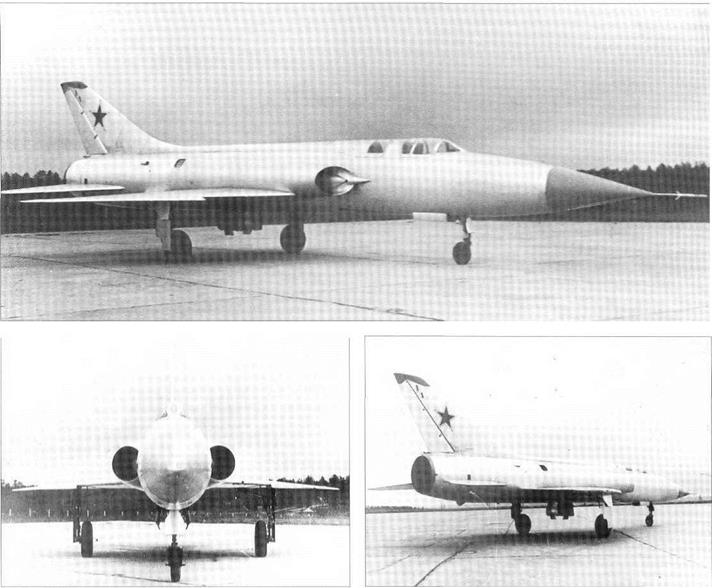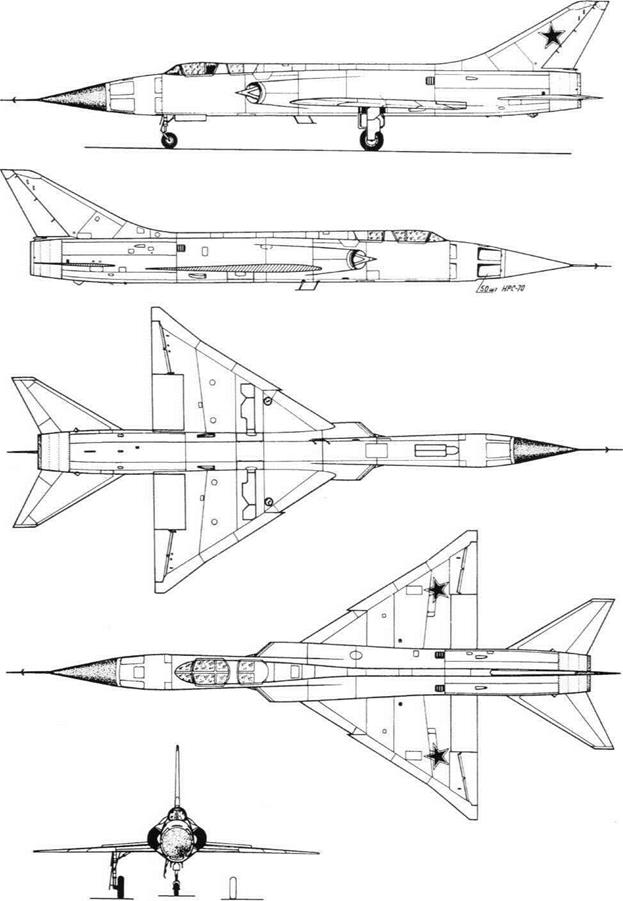Sukhoi PI
|
Purpose: To create a more capable interceptor for the IA-PVO (manned air – defence aviation).
Design Bureau: OKB-51 of P O Sukhoi, Moscow.
In December 1954 the MAP (Ministry of Aviation Industry) requested studies of a new fighter, called P (Perekhvatchik, interceptor). Studies embraced single – and two-seat aircraft armed with every combination of guns, rockets and guided missiles, and with nine types of afterburning turbojet. On 19th January 1955 the Council of Ministers ordered from Sukhoi prototypes of the P-l powered by a single AL-9 and the P-2 powered by two VK-11 engines. Mockups were reviewed in late 1955, and construction of the P-l was authorised, the P-2 being abandoned in early 1956. OKB-51’s factory constructed the single
P-l from August 1956. At a late stage it was recognized that the chosen engine would not be ready in time, and the aircraft was redesigned for an engine of rather less thrust in order to get it airborne. It was taken to the OKB’s flight-test station on 10th June 1957, and was flown there by Nikolai Korovushkin on 12th July 1957. He was joined by Eduard Elyan, and Factory Testing was completed on 22nd September 1958. The intended engine never did become available, and Sukhoi failed to obtain an alternative (the R-15B-300 went instead to the T-37). The P-l was transferred to the experimental category and finally abandoned.
Intended for a more powerful engine, the Lyul’ka AL-9 with an afterburning thrust of 10 tonnes (22,046Ib), the P-l was thus larger than all the other Sukhoi aircraft of its generation. The wing was scaled up from the earli
er PT-8, which had introduced the feature of a dogtooth discontinuity in the leading edge to create a powerful vortex at large angles of attack to keep flow attached over the upper surface. Unlike the PT-8 the leading-edge sweep was reduced at a point ahead of aileron mid-span from 60° to 55°. Otherwise the wing followed Sukhoi practice with rectangular slotted flaps, sharply tapered ailerons terminating inboard ofthe tips, landing gears retracting between Spars 1 and 2 and integral tanks ahead of Spar 1 and between Spars 2 and 3. The large fuselage was exceptionally complex. In the nose was the single dish antenna of the Pantera (panther) search and fire-control radar, with the multifunction instrumentation boom projecting from the tip. With this aircraft Sukhoi gave up
|
P-l (Note: one side view states that the rockets were the 70mm NRS-70).
|
trying to put the air inlet in the nose, and the radome formed the entire nose of the aircraft. Next came the bay housing the radar’s pressurized container, around which was the main armament. After many changes this comprised five bays, each closed by a rapid – action door, each housing ten ARS-57 57mm spin-stabilized rockets. Upon automatic command by the fire-control system, the rockets were either rippled in rapid sequence or fired in a single salvo, the doors quickly hingeing inwards from the front and the rocket gases being discharged through doors at the rear immediately ahead of Frame 8 (the front pressure bulkhead of the cockpit). Next came the nose landing gear, with a K-283 wheel with 570 x 140mm tyre, retracting to the rear, under the floor of the cockpit. The latter was of course pressurized, and accommodated the pilot and radar operator on tandem KS-1 ejection-seats under canopies hinged upwards from the rear. Next came the lateral engine air inlets, which broke new ground in being circular (as they were cut back at a Mach angle of45° they were actually ellipses), standing slightly away from the fuselage to avoid swallowing boundary-layer air, and housing a half-cone centrebody axially translated to front or rear according to flight Mach number. Downstream the air ducts, and thus the fuselage outer walls, curved sharply inwards to form the common tube feeding the engine. This gave area-rule flow over the wings (an account stating that this aircraft was not area-ruled is mistaken). Additional non-integral tanks occupied the space between the ducts, with piping in a dorsal spine linking the canopies to the fin (a new feature for Su aircraft). The engine was the well-tried AL-7F, rated at 6,850kg (15,101 Ib) dry and 8,950kg (19,731 Ib) with afterburner. At double Frames 36/36A the tail could be removed. The tail was similar to that of other Sukhoi prototypes of the era. So were the three hydraulic systems, the two flight-control systems serving a BU-49 power unit for the rudder, a BU-51 driving the one-piece tailplanes (this irreversible drive rendered anti-flutter masses unnecessary) and a BU-52 with rod linkages to the ailerons. The autopilot system used the AP-28 on the tailplanes and AP-39 laterally. The primary hydraulic system also drove the landing gear, the main units having KT-72 wheels with l,000x 280mm tyres, and the rocket doors, canopies, inlet centrebodies, flaps and (according to documents, though these do not appear on drawings and cannot be seen in photographs) three airbrakes on the rear fuselage. Another puzzle is that one document mentions two NR-30 guns under the nose (one on each side of the bottom rocket compartment, and these are shown in one drawing), while another states that ‘in the wing root was an armament section’, while two documents state that the main armament comprised two K-7 (replaced by K-8) guided missiles hung on underwing pylons. The latter would have been outboard, ahead of the ailerons. Another document states that there was provision for an external tank under the fuselage, but this would have been difficult to accommodate because of the landing-gear doors and telemetry antenna. Other avionics included RSIU-4 V radio, SPU-2 intercom, Go – rizont (horizon) guidance and data link, SRZO-2 IFF, SOD-57M transponder, Sirena-2 (siren) passive warning receiver, ARK-51 ADF, MRP-56P marker receiver, GIK-1 and AGI-1 navaids, RVU radio altimeter and the RSBN-2 tactical landing guidance.
This complex aircraft never received the intended engine.
|
Dimensions Span Length (incl instrument boom) Wing area (gross) (net) |
9.816m 21.83m 44m2 28.1 nf |
32 ft n in 71 ft 71* in 474ft2 302 ft2 |
|
Weights |
||
|
Empty |
7,710kg |
16,997 Ib |
|
Loaded (normal) |
10.6 tonnes |
23,369 Ib |
|
(maximum) |
11,550kg |
25,463 Ib |
|
Performance |
||
|
Maximum speed |
||
|
at 15 km (49,2 13 ft) |
2,050 km/h |
1,274 mph (Mach 1.93) |
|
Time to climb to 15km |
2.7 min |
(49,213ft) |
|
Service ceiling |
19,500m |
63,976 ft |
|
Range (internal fuel) |
1,250km |
777miles |
|
Landing speed |
220 km/h |
137 mph |













